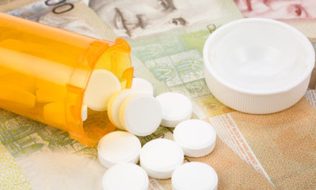

It’s interesting how certain areas in drug plan management can cause significant confusion and misunderstanding that can lead to inappropriate assumptions being made. It’s often impossible to trace back where certain notions have routinely become accepted as fact over the years and never questioned. These assumptions can lead to cost liabilities and waste.
There are two very common areas of folklore/mythology as they relate to the price of prescription drugs in Canada. First, the price of the drug is the same from pharmacy to pharmacy and that only the dispensing fee is different. And second, that a move to a pay-direct drug (PDD) card by default confers the same pricing controls from one plan sponsor to another.
Both of these can be very poor assumptions, and plan sponsors and plan advisors need to consider the impact of these myths on a given plan experience. Let’s consider a case looking at two different plans in Ontario in 2012, both with PDD plan structures. In addition, to eliminate the impact of skewing factor of the generic price changes across the country (including Ontario), we will only consider single-source brand drugs (i.e., brand name drugs that have no generic equivalents). Finally, we will only consider claims for solid, oral dosage forms (i.e., tablets, capsules, etc.) where pricing is not influenced by volume considerations or discrepancies in which unit of measurement is being considered.
Read more: Drug plan waste costs plan sponsors $5.1 billion: Report
Here’s what was found within the claims experience for Company A and Company B in 2012 [dispensing fees are not considered here, we are simply considering the mark-up on the manufacturer list price (MLP) of the single-source brand drugs in the experience]:
Range of mark-ups on drug ingredient costs submitted by pharmacies for payment
Company A: MLP + 9.2% to MLP + 44.0% (Average of MLP + 19.4%)
Company B: MLP + 6.9% to MLP + 42.4% (Average of MLP + 18.9%)
Range of mark-ups on drug ingredient cost eligible for payment (following PDD adjudication)
Company A: MLP + 9.2% to MLP + 15.1% (Average of MLP + 14.6%)
Company B: MLP + 6.9% to MLP + 26.8% (Average of MLP + 18.5%)
While the range in submitted drug costs is very similar between the two experiences, it’s remarkable to see the impact of various PDD protocols on the average cost of a claim. These differences in eligible mark-ups are not insignificant when one considers that Company A had an average amount paid per claim on single-source brand drugs in 2012 of $122.15 and Company B had an average amount paid per claim on single source brand drugs during the same period of $129.25. Therefore, when one considers the nearly 4% difference in the average mark-up over MLP that was paid by Company B, and the average drug ingredient cost for these claims, one realizes that this situation is costing Company B more than $4 extra per claim.
It’s ironic to hear stories of plan sponsors who have (or have seriously considered) changing vendors for relatively small difference in administrative services only fees or premiums, yet here Company B is flushing an additional 4% of mark-up down the toilet for every claim paid simply because nobody is paying attention to mark-ups.
Read more: Drug plan management for the 99.4%
Is that extra $4 per claim above adding any more value to Company B’s plan members? What about to Company B itself? If not, why is that tolerated?
Another interesting observation from the case study above is the wide range of mark-ups that are still seen in the market today between pharmacies, even after a wave of generic drug pricing legislative changes and more scrutiny than ever before on drug costs. Some might be quick to point out that the higher mark-ups seen above are simply due to considering drugs with relatively low unit costs, so even a small difference in mark-up could result in a large percentage mark-up over MLP.
That argument doesn’t hold much water though when you consider:
- The example above considers solid, oral dosage forms of brand name drugs that have unambiguous pricing, and one would be hard-pressed to find many single-source brand drugs that have unit costs of only a few pennies. That might well be the case for some common generic products, but go ahead and try to name common patent-protected products that cost only a few pennies per tablet or capsule.
- In Company B’s case, the average mark-up eligible was 18.5% across all claims for single-source brand drugs, yet some stores in the experience had 7%, 9% or 11% mark-ups. That’s a very material difference on claims that cost the plan well over $100 on average.
I have to think a plan sponsor can think of many better ways to invest that kind of waste in a way that actually produces some tangible value for both the plan member and the sponsor. This case is hopefully some food for thought: before making an assumption in this area, it may be worth verifying the information.
Read more:
